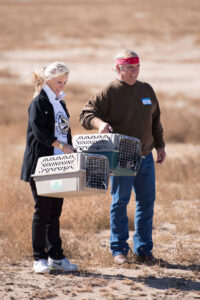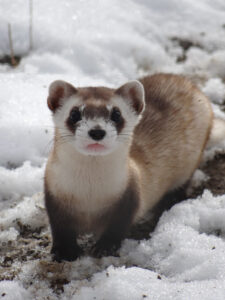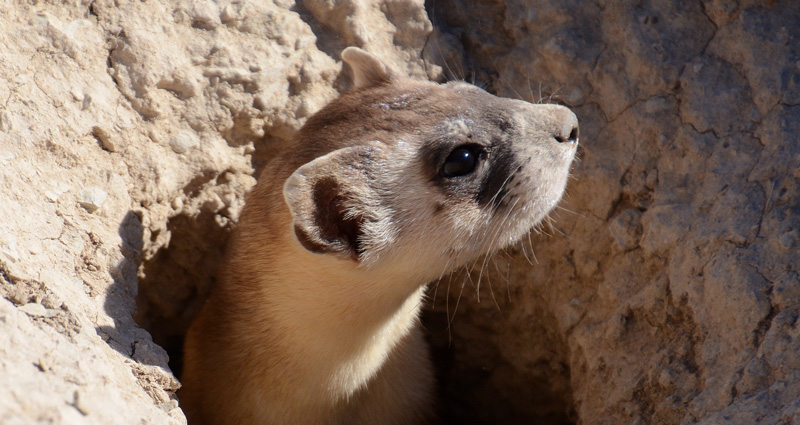On a blustery day in early November, a school bus lumbers through a private gate and down a dusty two-track road on Walker Ranch in Pueblo County. With a whoosh of its air brakes, it comes to a halt.
“Here come our helpers,” says Ed Schmal, southeast region wildlife biologist with Colorado Parks and Wildlife. Schmal, who manages black-footed ferret recovery on the ranch, walks over to greet the children.
Fifty fourth grade students from Morton Elementary School in Pueblo pour out of the bus and into the fresh air and sunshine. The kids talk nonstop, excited to see the most endangered mammal in North America. The U.S. Fish and Wildlife Service — which oversees the nationwide breeding, protection, and reintroduction of the black-footed ferret — has invited the local students to help release a few into the wild. It’s a rare opportunity.
BACK FROM THE BRINK
Black-footed ferrets, the only ferret native to the Americas, thrived for 100,000 years across the Great Plains between Canada and Mexico. When European settlers arrived in the 1800s, they brought new diseases, plowed through grasslands, and began poisoning the ferret’s primary source of food and shelter: the prairie dog. According to USFWS, there may have been as many as one million black-footed ferrets in the late 1800s. But by the end of the 1970s, the species was presumed extinct.
By some miracle in 1981, a colony of 129 ferrets was discovered on a ranch near Meeteetse, Wyoming, giving biologists a second chance to save the Lazarus species. But sylvatic plague and canine distemper quickly decimated the wild ferret’s numbers, once again threatening the small carnivore with extinction.
Scientists captured the remaining ferrets, and thanks to efforts led by the Wyoming Game and Fish Department, USFWS, and other partners, seven of the Meeteetse survivors were able to reproduce in captivity. The Magnificent Seven became the founding mothers and fathers of all future generations of black-footed ferrets in the world.
An estimated 300–500 black-footed ferrets live in the wild today, and Colorado is one of eight Western states bringing the federally protected species back to its historic geographic range. Of the 34 reintroduction sites between Arizona and Montana, nine are in Colorado. The release at Walker Ranch will add 13 more ferrets to the wild population.
THE KEY TO RECOVERY
“Collaboration is key,” says Justin Chuven, recovery program coordinator for the USFWS National Black-Footed Ferret Conservation Center near Fort Collins. Founded in 2001, the Colorado facility is the largest of six captive-breeding programs in North America, which includes five zoos. “Black-footed ferret recovery would not be possible without the partnership of tribal, state, and federal agencies, private landowners, multiple zoos, nonprofits, and more,” he says. “There’s no way that we, or any other single entity, could do it on our own.”

Georgia and Gary Walker, owners of Walker Ranch, help during an earlier ferret release. Photo courtesy of Gary Walker.
Ferret recovery in Colorado also involves the U.S. Army, Colorado Cattleman’s Association, City of Fort Collins Natural Areas, grazing associations, universities, and land trusts, among many other entities.
Because the majority of land in Colorado is privately owned, Schmal says that ferret recovery would be nearly impossible without the cooperation of private landowners.
“Ranchers are some of the best conservationists out there, and some of the most important partners we have at Colorado Parks and Wildlife,” Schmal says. He points to the owners of Walker Ranch as good examples. “Gary and Georgia are just amazing people. They have this land ethic, this conservation ethic, that drives everything they do. That’s why we have such large open spaces around our community for wildlife.”
Ranchers are some of the best conservationists out there, and some of the most important partners we have at Colorado Parks and Wildlife. Gary and Georgia are just amazing people. They have this land ethic, this conservation ethic, that drives everything they do. That’s why we have such large open spaces around our community for wildlife.” — Ed Schmal, CPW
VITAL ROLE OF PRIVATE LANDOWNERS
At nearly 80,000 acres of shortgrass prairie, Walker Ranch sprawls across western Pueblo and eastern Fremont counties. It’s a working cow-calf operation run by husband and wife Gary and Georgia Walker — the first private landowners in Colorado to allow the reintroduction of black-footed ferrets on their property.
Gary Walker has worked this land for 60 years. He and his wife bought the family ranch in 1994 and nearly tripled its acreage over time. Out of all the properties they could have purchased, the Walkers chose the historically overpoached and overgrazed land west of Pueblo. “It needed us the most. It needed us to fix it.”
In the early days of owning the ranch, native elk, deer, turkey, and bighorn sheep populations were nonexistent. “Things were out of balance,” Gary says of the ecosystem, a fact that troubled him deeply. “Any rancher worth his salt cares about the health of the land.”
When it comes to prairie dogs, however, the Walkers have never been fans. Although most ecologists would disagree, many ranchers believe that prairie dogs take prime forage away from cattle, and take shortgrass prairies down to where it can’t recover.
Prairie dog burrows, like hollow booby traps, can also cause serious injury. One day, while moving cattle across a pasture, Gary’s quarter horse plunged through a burrow and fell hard, crushing him. The rancher suffered 30 fractures, including a broken back and collarbone. His recovery was long and painful.
“Do I love prairie dogs? No. But I love black-footed ferrets and other wildlife more,” he says, knowing a healthy prairie dog population is key to a healthier wildlife population in general, including raptors, swift foxes, songbirds, burrowing owls, and others. “I protect the [prairie] dogs to protect it all.”
Today on Walker Ranch, more than 3,000 acres for prairie dogs are protected under a voluntary safe harbor agreement with the USFWS, and 170 black-footed ferrets have been released there since 2013. By doing so, Gary and Georgia are eligible for ferret-related financial incentives provided by CPW and the federal Natural Resources Conservation Service. But it’s not about money for the Walkers. The greatest reward, Gary says, is how good it makes him feel to restore balance to the landscape. “We’re trying to do the right thing for this land,” Gary says, proud to bring a natural predator of the prairie dog back to the ranch. Because of the family’s lifelong commitment to conservation, Walker Ranch is once again home to large herds of elk, deer, pronghorn, and bighorn sheep, flocks of wild turkeys, and a growing population of critically endangered black-footed ferrets.
CHALLENGES AND SOLUTIONS
“The greatest threat to the ferret is sylvatic plague,” Schmal says without hesitation. The deadly exotic disease, spread by fleas, can wipe out entire colonies of prairie dogs and ferrets in a matter of weeks.
Twice each year, Schmal and his team dust active burrows for fleas, and they bait the prairie dogs with tasty oral vaccine pellets to combat the plague.
Before releasing new ferrets, biologists vaccinate and microchip them for future monitoring. But just because a ferret is chipped doesn’t make it easy to track. Ferrets are solitary, nocturnal creatures that live mostly underground. Current chip readers — rings placed over burrow holes — can only count animals that exit a tunnel through the ring. It’s a matter of chance, making it tough to gather accurate headcounts.

Photo by Justin Chuven, U.S. Fish and Wildlife Service, National Black-Footed Ferret Conservation Center.
Surveying the health and activity of ferrets also means countless cold, dark nights of spotlighting from trucks in the hope of seeing that distinctive emerald-green eyeshine. Spotting wild kits is a major sign of success, but vaccinations don’t transfer from the captive-bred parent, so biologists need to catch, chip, and vaccinate wild-born kits. To make the job even harder, ferrets are notoriously trap-shy.
To help biologists do their job more efficiently, scent dogs are being trained to find ferrets in the field. In an effort to save money, CPW pioneered a more affordable technique for mass-producing oral vaccine pellets. And to make distributing the pellets easier, the USFWS and the World Wildlife Fund are developing faster delivery methods, including the use of drones and ATVs. According to Schmal, scientists at the Smithsonian Conservation Biology Institute are working to replace ring readers with remote GPS satellite monitoring capabilities, an eagerly anticipated next-gen technology.
Scientists are also addressing the ferret’s genetic diversity conundrum through cutting-edge research. With the proven ability to clone ferrets, the USFWS and its partner zoos are working toward diversifying the gene pool to reduce the risk of inbreeding.
FERRETING OUT A FUTURE
Back on Walker Ranch, the fourth graders whoop and holler as they run up and over a small hill. The chilly wind is picking up, and they return with rosy cheeks. This wideopen landscape is the perfect place for kids to stretch their growing legs and release energy. Walker Ranch is the perfect place to release the young black-footed ferrets, too.
Schmal gazes across a sea of dormant grasses and shrubs toward the distant horizon. “It may not look like it’s a very rich environment for wildlife, but when you get out there and start looking around, it’s incredibly rich,” he says. “There’s so much life out there. It’s just phenomenal.”
Chuven and his team arrive from the National Black-Footed Ferret Conservation Center located 200 miles north. It’s been a long drive. They open the back of their government vehicle, revealing 13 pet carriers holding captive-bred ferrets. Each animal graduated from a 30-day preconditioning program at the facility, having to prove, among other things, they could hunt live prey.
The children, once boisterous with excitement, now hush one another so they can hear the ferret’s distinct chatter. The animals poke curious noses through their cage doors.
CPW and USFWS biologists lead smaller groups of students to the prairie dog burrows preselected by Schmal. In each group, one student hauls a ferret cage. Another carries a long, protective leather glove. A third volunteer pinches a blue surgical glove between their index finger and thumb. Inside is a dead hamster, the ferret’s last free meal.
In Chuven’s group, the kids gather around an active prairie dog burrow hole, but not too closely. A young girl slides her hand into the massive leather glove, which swallows her entire arm. Proportional to their body size, ferrets have the largest canines of any mammal in North America — the glove is mandatory safety equipment. She unlocks the door of the carrier and holds it open. Chuven removes some of the nesting material and tilts the cage forward. The kids hold their breath.
I love seeing the smiles on their faces, hearing their laughter, hearing them talk about it. Any chance we get to bring kids out into the natural world, and help them see what’s happening, that’s how we create the next generation of conservationists. This is where it starts.” — Ed Schmal, CPW
A shy black-footed ferret, fully grown at 2 pounds, finally pokes its small, masked face through the open door. It looks around the circle of kids for a few seconds, sniffs the air, then darts down the tunnel into its new home.
The teacher corrals her students, reminding them to thank the biologists before heading back toward the ranch gate. The kids skip across the open prairie, kicking up dust. With animated faces and hands, they relive favorite parts of the day with their classmates as they climb aboard the waiting bus.
“I love seeing the smiles on their faces, hearing their laughter, hearing them talk about it,” Schmal says. “Any chance we get to bring kids out into the natural world, and help them see what’s happening, that’s how we create the next generation of conservationists. This is where it starts.”
When asked about the future of the black-footed ferret, Chuven is optimistic. “There are many people dedicating their lives to solving the problems that challenge this animal’s recovery,” he says. “It’s going to take a lot more effort, and many more years, but this is a story of success. It’s a reason for hope.”
Becky Jensen is a writer and podcast contributor who lives and works in a little cabin on a big river in Northern Colorado. She’s a former farm girl turned mountain mama and a proud member of Poudre Valley REA. You can find her at beckyjensenwrites.com.

